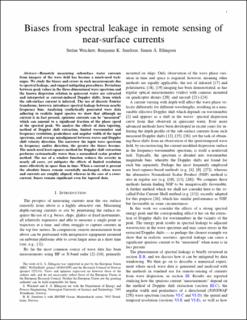Biases From Spectral Leakage in Remote Sensing of Near-Surface Currents
Journal article, Peer reviewed
Accepted version
Permanent lenke
https://hdl.handle.net/11250/3104020Utgivelsesdato
2023Metadata
Vis full innførselSamlinger
- Publikasjoner fra CRIStin - SINTEF Ocean [1312]
- SINTEF Ocean [1384]
Originalversjon
IEEE Transactions on Geoscience and Remote Sensing. 2023, 61 . 10.1109/TGRS.2023.3321305Sammendrag
Remotely measuring subsurface water currents from imagery of the wave field has become a much-used technique. We study the biases and errors in such measurements due to spectral leakage and suggest mitigating procedures. Deviations between peak values in the 3-D wave spectrum and the known dispersion relation in quiescent water are extracted and interpreted as current-induced Doppler shifts, from which the subsurface current is inferred. The use of discrete Fourier transforms (DFTs), however, introduces spectral leakage between nearby frequency bins. Analyzing synthetically generated wave data adhering to realistic input spectra, we show that although no current is, in fact, present, spurious currents can be “measured,” which can amount to a significant fraction of the phase speed at the spectral peak. We analyze the effects of data tapering, method of Doppler shift extraction, limited wavenumber and frequency resolution, peakedness and angular width of the input spectrum, and average misalignment between waves and Doppler shift velocity (DSV) direction. The narrower the input wave spectrum in frequency and/or direction, the greater the biases become. The use of a window function reduces the severity in nearly all cases, yet mitigates the effects of limited resolution more effectively in space than in time. When a current is present, the absolute biases remain essentially unchanged, when waves and currents are roughly aligned; whereas in the case of a cross current, biases remain significant even for tapered data.
Beskrivelse
Postprint version of published article

